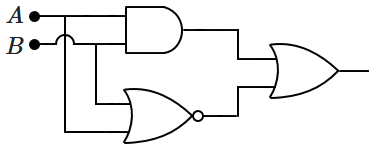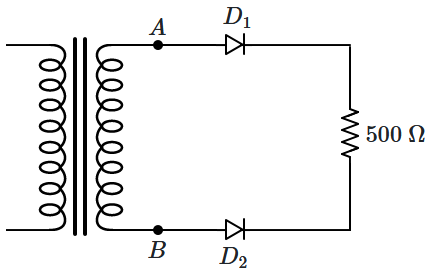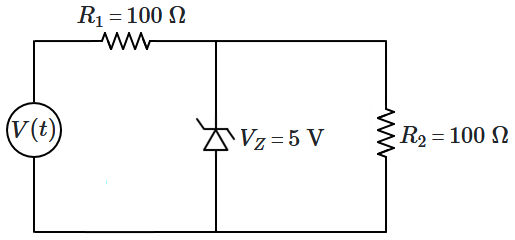Which of the following represents a circuit that gives an output (i.e. true) when both its inputs are equal?
1.

2.

3.

4.






To unlock all the explanations of this course, you need to be enrolled.

To unlock all the explanations of this course, you need to be enrolled.

This diode is connected with a resistance of \(5~\Omega\) in series with it as shown below:

Which of the following shows the dependence of the voltage \(V_{AB}\) and the current \(i,\) when the diode is forward-biased?
(\(V_{AB}\) in volt, \(i\) in ampere)
| 1. | \(V_{A B}=i\cdot5+0.6\) |
| 2. | \(V_{A B}=i\cdot5-0.6\) |
| 3. | \(V_{A B}=i\cdot5+(0.6-5)\) |
| 4. | \(V_{A B}=i\cdot5+\left(0.6+5\right)\) |

To unlock all the explanations of this course, you need to be enrolled.

To unlock all the explanations of this course, you need to be enrolled.
(consider the diodes as ideal.)

| 1. |  |
2. |  |
| 3. |  |
4. |  |

To unlock all the explanations of this course, you need to be enrolled.

To unlock all the explanations of this course, you need to be enrolled.

| 1. | \(V_o=V_i+E\) |
| 2. | \(V_o=V_i-E\) |
| 3. | \(V_o=V_i,\) only when \(V_i>E\) |
| 4. | \(V_o=V_i,\) only when \(V_i<E\) |

To unlock all the explanations of this course, you need to be enrolled.

To unlock all the explanations of this course, you need to be enrolled.

1. \(V_A>V_B+V_0\)
2. \(V_A<V_B+V_0\)
3. \(V_A>V_B-V_0\)
4. \(V_A<V_B-V_0\)

To unlock all the explanations of this course, you need to be enrolled.

To unlock all the explanations of this course, you need to be enrolled.

| 1. | no current flows in the circuit |
| 2. | current flows anticlockwise |
| 3. | current flows clockwise |
| 4. | current only flows through \(D_2\) and not through \(D_1\) |

To unlock all the explanations of this course, you need to be enrolled.

To unlock all the explanations of this course, you need to be enrolled.
 1. zero
1. zero2. \(4~\text{mA}\)
3. \(2.5~\text{mA}\)
4. \(0.8~\text{A}\)

To unlock all the explanations of this course, you need to be enrolled.

To unlock all the explanations of this course, you need to be enrolled.
 1. zero
1. zero2. \(20\) mA
3. \(40\) mA
4. \(20\sqrt2\) mA

To unlock all the explanations of this course, you need to be enrolled.

To unlock all the explanations of this course, you need to be enrolled.

| 1. | AND | 2. | OR |
| 3. | NOR | 4. | XOR |

To unlock all the explanations of this course, you need to be enrolled.

To unlock all the explanations of this course, you need to be enrolled.

For the above circuit, the applied voltage \(V(t)\) is periodic and linear, and is shown by the waveform below:

The current flowing through \(R_2\) varies as:
| 1. |  |
2. |  |
| 3. |  |
4. |  |

To unlock all the explanations of this course, you need to be enrolled.

To unlock all the explanations of this course, you need to be enrolled.






